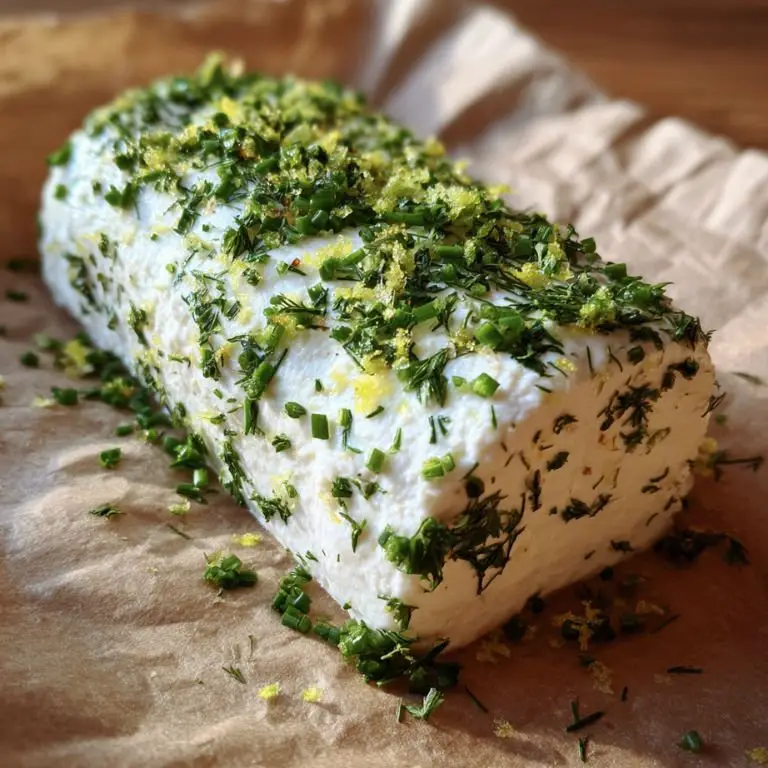Looking for a spreadable, tangy, and creamy treat that tastes just like the real thing but is 100% plant-based? This vegan goat cheese with fresh dill and chive coating delivers all the punch of traditional goat cheese without the dairy. It’s perfect for anyone craving goat cheese snacks or an elegant goat cheese appetizer easy enough for weekday entertaining but fancy enough to serve at a wine and cheese night. This is a must-try vegan goat cheese recipe that will surprise even your non-vegan friends.
Whether you're vegan, lactose-intolerant, or just dabbling in healthy plant-based cheese, this DIY vegan cheese idea transforms a handful of simple ingredients into a show-stopping centerpiece. The flavor is herby, lemony, tangy, and satisfyingly savory. With its creamy texture and aromatic fresh herb coating, it spreads beautifully on crackers or sandwiches and even holds up well when crumbled over salads or warm toast.
Vegan Goat Cheese with Fresh Dill and Chive Coating
Prep Time 15 minutes mins
Chilling Time 8 hours hrs
Total Time 8 hours hrs 15 minutes mins
Course Appetizer, Condiment, Snack
Cuisine European
High-speed blender or food processor Essential for creating that creamy, goat-cheese-like texture. A blender like Vitamix or NutriBullet works best, but a strong food processor will also get the job done.
Cheesecloth or nut milk bag Used for draining the cheese and helping it firm up. If you don’t have one, a clean kitchen towel works in a pinch.
Mixing bowl For combining your coating ingredients.
Spatula To help scrape every last bit of cheese out of the blender.
Parchment paper For rolling the cheese into a log or patty.
For the Cheese Base
- 1 ½ cups raw cashews soaked in hot water for 2 hours or overnight in room temp water
- 2 tablespoons lemon juice freshly squeezed
- 1 tablespoon apple cider vinegar
- 2 tablespoons unsweetened plain coconut yogurt or any thick plant-based yogurt
- ¾ teaspoon sea salt
- 1 tablespoon nutritional yeast for a subtle cheesy depth
- 1 garlic clove minced
For the Coating
- 2 tablespoons fresh dill finely chopped
- 2 tablespoons fresh chives finely chopped
- Zest of 1 lemon
Soak the Cashews
Start by soaking the cashews in hot water for at least 2 hours. This softens them and ensures a creamy final texture. If you have more time, an overnight soak in room temperature water works too.
Blend the Cheese Base
Drain the soaked cashews and place them into your blender or food processor. Add lemon juice, apple cider vinegar, coconut yogurt, sea salt, nutritional yeast, and garlic. Blend on high until smooth and creamy, scraping down the sides as needed. You may need to add a teaspoon or two of water to help blend, but don’t add too much or it won’t firm up.
Let It Ferment (Optional but Recommended)
For an extra tang that mimics real goat cheese, scoop the mixture into a clean glass bowl, cover loosely, and let it sit at room temperature for 12–24 hours to lightly ferment. This step elevates the flavor and adds complexity, but it’s optional.
Chill and Shape the Cheese
Transfer the cheese mixture onto a piece of parchment paper and use the paper to shape it into a small log or round. Wrap it up and place it in the fridge for at least 8 hours, or until firm.
Prepare the Herb Coating
Mix the chopped dill, chives, and lemon zest in a small bowl. Once the cheese is firm, unwrap it and gently roll it in the herb mixture, pressing lightly so the coating sticks.
Serve or Store
Serve immediately or wrap again and store in the fridge for up to 5 days. The flavor develops more over time, making it even better the next day.
Pairings
This versatile vegan cheese is endlessly pairable. Here are some delicious ways to enjoy it:
- Goat cheese salad recipes: Crumble it over a bed of arugula, cherry tomatoes, and roasted beets for a vibrant, creamy finish.
- Goat cheese sandwich: Spread a thick layer on toasted sourdough with grilled zucchini, red peppers, and balsamic glaze.
- Baked goat cheese (vegan style): Dollop onto roasted butternut squash or eggplant halves before broiling for a warm, melty, tangy topping.
- Goat cheese breakfast: Slather it on an English muffin with sliced avocado and everything bagel seasoning.
- Goat cheese appetizer easy setup: Serve on a platter with crackers, olives, cucumber slices, and sun-dried tomatoes for a quick Mediterranean-style nibble.
- Goat cheese sauce alternative: Thin it with a bit of warm water or almond milk to create a creamy sauce for grain bowls or roasted veggies.
Frequently Asked Questions
1. Can I substitute cashews with something else?
Yes, though cashews provide the creamiest texture. You can use blanched almonds or macadamia nuts as an alternative. Keep in mind the flavor and texture might be slightly different.
2. Is this cheese good for baking or cooking?
While it's not ideal for melting like store-bought vegan cheese, it holds up well in warm dishes like stuffed peppers or added to cooked pasta as a creamy dollop—great for goat cheese recipes dinner options.
3. What makes this a “goat cheese” if it’s vegan?
This vegan goat cheese replicates the tangy, creamy texture of dairy goat cheese using plant-based ingredients. The lemon juice, apple cider vinegar, and optional fermentation give it that classic "funk" without any animal products.
4. Can I make this ahead of time?
Absolutely! In fact, making it a day or two ahead deepens the flavor. Store it in an airtight container or wrapped in parchment in the fridge.
5. How can I make this more spreadable?
If you prefer a more spreadable version (think cheese dip), just blend it with a tablespoon or two of water or plant milk after it firms up. It becomes a perfect topper for bagels or crackers and even doubles as a tangy vegan feta cheese alternative.
